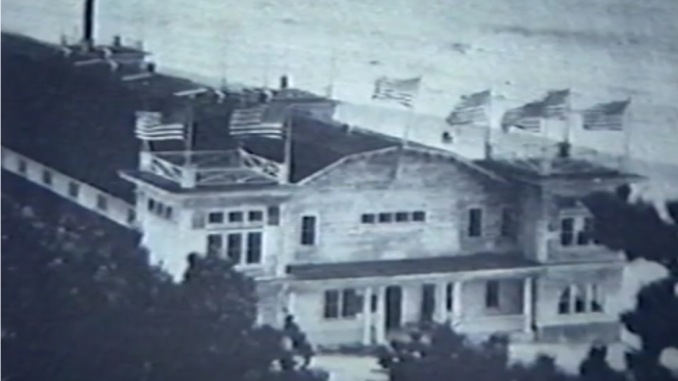
On the Oregon coast, where the Tillamook River flows into the sea, there’s a sheltered inlet called Tillamook Bay, The peninsula which protects the bay from the Pacific Ocean was called Tillamook Spit prior to the year 1907. The only way to get there was either on foot, on horseback, or by boat. About four miles long and varying in width, “the spit” was nothing more than a sandbar, topped with sand dunes of various heights. All that sand had been placed there by the action of ocean currents interacting with the natural geography of the coastline.
In 1906, Thomas Irving Potter, the son of wealthy California real estate developer Thomas Benton Potter, first saw the spit while on a sportsman’s trip. T.I. Potter envisioned a vacation resort town on the peninsula between the bay and the ocean, complete with a grand hotel and amenities that few towns or even cities of the time could boast of.
In addition to the enormous hotel, there would be paved streets (although no roads in or out of town), running water, electricity (powered by diesel generator), a telephone system (that didn’t connect to the outside world), a narrow-guage railroad connecting to Portland, a rustic dance hall, a bowling alley, an amusement park to rival Coney Island, and various other entertainment. Streets and subdivision would be layed out and lots would sell to future residents to build new homes on, and also to speculative investors. Passenger ships would deliver people to the resort via a long dock out in the bay.
To top it all off there would be, combined in one building, a movie theater with seating for one-thousand patrons, and a natatorium with an indoor heated salt water pool. The pool would have a mechanical wave generating machine (for those who wanted to experience the ocean without having to actually go in it) and an orchestra to entertain the swimmers. (The orchestra also was expected to perform at the grand hotel and the dance hall).
T.I. Potter convinced his father, T.B. Potter, and his father’s business partner, Harkness Lucius Chapin, to go all in on the project, which they named Bayocean Park. Initially lots sold well, and there were plently of investors. The venture soon raised $800,000 but, unfortunately the lots sold were on “no down” contracts and the financial Panic of 1907 created a problem for the business partners in the way of collecting payments.
There were cash flow shortages and numerous other difficulties, but the organizers pressed on, and the town grew. In the summers, the population ballooned with vacationers, many of whom stayed in cabins or tents in “Tent City”.
The grand hotel and amusement park were never built, although much of the other planned amenities were, including the natatorium. There were still no roads to Bayocean, and the promised rail line to Portland still did not exist. The only convenient way for most people to reach Bayocean was by ship. While more convenient than the alternatives, it was not exceptionally popular because of the very rough water encountered where the bay drained into the Pacific at the north end of the peninsula. Apparently it was a terrifying enough experience for the townspeople to demand something be done about it.
The US Army Corps of Engineers (USACE) were contacted and asked to help. The engineers recommended building two jetties, one on either side of the entrance to the bay at a cost of $2.2 million dollars. The catch was, the residents would have to pay half. This was an unaffordable proposition, but they were willing to pay half of the cost for one jetty.
USACE began work on the one jetty on the north side of the inlet in 1914, and completed it in 1917. The new jetty calmed the waters at the inlet, but at the cost of simultaneosly interfering with the currents that had created the spit peninsula. Wave action, especially during the severe winter storms, began eroding away the sand that Bayocean was built on.
By the 1920s, the erosion was bad enough that some home owners had their houses moved back away from the ocean, while others did not and lost their homes to the sea. Then in 1931 the jetty was lengthened and the rate of erosion drastically accelerated. The natatorium was closed and abandoned in 1932. Throughout the 1930s numerous buildings were lost and many owners abandoned their properties. By the early 1950s, the last of the most stubborn owners had left Bayocean for good. In 1960, the last stucture fell into the ocean.
The second jetty, on the south side of the inlet, was built in the 1970s to help restore the environment and ecosystem of the bay. Not only did this stop the erosion, but the ocean currents began to deposit sand back on the spit.
Today the place is owned by Tillamook County and known as Bayocean Peninsula Park. Mostly it has returned to the wild, natural, state Thomas Irving Potter found it in.
The failure of Bayocean is an object lesson in the unintended consequences that result from a lack of respect for nature.
Ther’s much more to tell, and pictures add a lot to this story, so I recommend the following links to anyone interested in learning more:
• Bayocean Video (11:35)
• Bayocean, Oregon, The resort town destroyed by the sea
• pdxhistory.com
Question of the night: What’s your idea of a great way to vacation?
